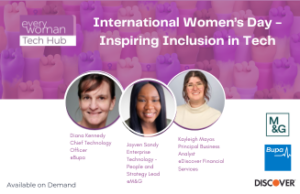
In every corner of the business at Lenovo there are female trailblazers, demonstrating first hand that a career in technology is challenging, exciting and rewarding. Ola Eldib, Country Manager for Lenovo Egypt and Levant, and Roberta Marchini, Director of European Technical Solutions Support, exemplify the female trailblazers at Lenovo who are paving the way for women in STEM.
Ola has risen through the ranks to lead a thriving, diverse office, as well as participating in the Lenovo Mentoring Programme. She’s helped develop the Promoters Internship, ushering more women into the tech industry.
Roberta, meanwhile, has an equally illuminating story. Having studied engineering in Milan, she progressed quickly in the technology sector, eventually bringing her engineering expertise to her current role.
Why are there fewer women in STEM?
From a young age, both Ola and Roberta realised that they were in the minority, and a combination of societal bias, self-limitation and a lack of strong role models was holding young girls back from pursuing careers within STEM (Science, Technology, Engineering and Maths).
‘I have seen first-hand the challenges women face when it comes to employment in STEM’, says Ola, ‘There are multiple barriers that limit entry into these careers, including the fact that women often assume a disproportionate share of childcare and household responsibilities.’
Roberta echoes this, adding that many women simply do not see themselves represented in, nor are encouraged to enter, STEM career pathways. ‘It starts at childhood’ she says. ‘There are not enough role models, and societal pressures often dictate how women believe they should behave. This lack of representation is holding women back.’
The experience that Ola and Roberta outline is not an isolated one. According to Business Chief, today women make up only 30% of the workforce in STEM careers, while men vastly outnumber women majoring in most STEM fields at higher education.
Bridging the gap
Stereotypes are often introduced young, and many of them serve to discourage girls from exploring a career in STEM. When you are asked to picture a scientist, mathematician or engineer, the chances are you’re probably picturing a man. In the words of Christine Dehnel, ISO WW Sales Transformation Director: ‘This is a problem. Representation matters and if young girls can’t see themselves in today’s STEM workers, how will they become the STEM workers of tomorrow?’
So, for Lenovo, bridging the gender gap means supporting programmes which seek to radically overhaul the perception of women in STEM careers, widening access and participation from day one.
Christine Dehnel has partnered with Becomtech to do just that. The partnership, now entering its third year, lives predominately through the Jump In Tech and other school holiday activities. Jump In Tech trains girls not only in computer programming and digital communications but also in soft skills, over an intensive four-week period, and with Lenovo’s support has now reached 500 young women.
The partnership has also built on an existing relationship with Centre Charles Péguy, an NGO providing after-school support to the children of Garges-lès-Gonesse schools. The NGO, which has many minority and refugee pupils, has collaborated with Lenovo and Becomtech to jointly propose holiday activities where young girls develop STEM skills through challenges and hackathons like building web pages and learning how to code.
Meanwhile, in South Africa, Jane Govindsamy, CSI Champion, has been working with local charity GirlCode to address the chronic shortage of skills and lack of women in tech, as well as introduce a wider audience of young girls to coding. The partnership is executed through a year-long programme which culminates in a Hackathon, where the girls put their newfound skills to the test.
Both of these partnerships seek to address the STEM gap at its source, exposing young women to strong role models, as well as encouraging them to build skills which may lead to a fruitful and rewarding career.
The retention problem: Female inclusion in STEM
But this is just the start, as research finds that some establishments are falling short of their responsibilities to women once they’re in STEM careers.
Failing to create an environment that is welcoming and inclusive means that currently women are one and a half times more likely than men to leave STEM within a year. So, at Lenovo, we’re committed to not only encouraging more young women to pursue careers in STEM, but fostering a workplace environment that makes them want to stay.
Policies such as agile working and working from home allow our team members with families to find the balance between Lenovo and home life. Education and development opportunities allow our female employees to flourish and develop in their roles, while our ‘no compromise’ approach on ethics and diversity seeks to create a work environment that attracts and retains talent.
The Future of STEM
Looking back, Roberta Marchini doesn’t remember any of her female friends wanting to be an engineer or a mathematician: ‘I think they all wanted to be princesses or ballerinas’, she recalls.
Today, things look a little different. The number of women in Europe in STEM careers has grown by 10% in the last decade. Increased opportunities, evolutionary workplace practices and the slow breaking down of barriers now mean that young girls can see themselves as much a tech engineer as a ballerina.
Systemic change is slow and there is always more work to be done. But if you cast your eyes ahead, the future looks bright for women in STEM.



